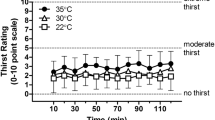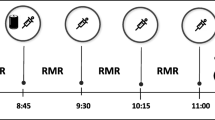Abstract
Purpose
Hot compared to cold drinks alter sweating responses during very low intensity exercise in temperate conditions. The thermoregulatory, perceptual, and performance effects of hot compared to cold drinks in hot, dry conditions during high-intensity exercise have not been examined.
Method
Ten participants [mean ± SD characteristics age 25 ± 5 years, height 1.81 ± 0.07 m, body mass 73.5 ± 10.6 kg, maximal power output (PMax) 350 ± 41 W] completed two conditions, where they drank four boluses (ingested at − 9, 15, 30, and 45 min, respectively) of 3.2 mL kg− 1 (~ 960 mL total) of either a COLD (5.3 °C) or a HOT drink (49.0 °C), which were contrasted to a no-drink CONTROL. They cycled for 60-min [55% PMax in hot (34.4 °C) dry (34% RH)] ambient conditions followed by a test to exhaustion (TTE; 80% PMax). The thermoregulatory, performance, and perceptual implications of drink temperature were measured.
Results
TTE was worse in the CONTROL (170 ± 132 s) than the COLD drink (371 ± 272 s; p = 0.021) and HOT drink conditions (367 ± 301 s; p = 0.038) which were not different (p = 0.965). Sweat responses [i.e., reflex changes in mean skin temperature (Tmsk) and galvanic skin conductance] indicated transient reductions in sweating response after COLD drink ingestion. The COLD drink improved thermal comfort beyond the transient changes in sweating.
Conclusion
Only COLD drink ingestion changed thermoregulation, but improved perceptual response. Accordingly, we conclude a role for gut thermoreception in thermal perception during exercise in hot, dry conditions.





Similar content being viewed by others
Abbreviations
- ANOVA:
-
Analysis of variance
- ACSM:
-
American College of Sports Medicine
- FI:
-
Fixed intensity
- GSC:
-
Galvanic skin conductance
- GC:
-
Gut comfort
- HR:
-
Heart rate
- P Max :
-
Maximal power output
- T msk :
-
Mean skin temperature
- RPE:
-
Rating of perceived exertion
- T rec :
-
Rectal temperature
- RH:
-
Relative humidity
- SkW:
-
Skin wetness
- SD:
-
Standard deviation
- TTE:
-
Test to exhaustion
- TC:
-
Thermal comfort
- TS:
-
Thermal sensation
- WBGT:
-
Wet bulb, globe, temperature
References
Amano T, Gerrett N, Inoue Y, Nishiyasu T, Havenith G, Kondo N (2016) Determination of the maximum rate of eccrine sweat glands’ ion reabsorption using the galvanic skin conductance to local sweat rate relationship. Eur J Appl Physiol 116(2):281–290. https://doi.org/10.1007/s00421-015-3275-9
American College of Sports Medicine, Sawka MN, Burke LM, Eichner ER, Maaughan RJ, Montain SJ et al (2007) American College of Sports Medicine position stand: exercise and fluid replacement. Med Sci Sports Exerc 39(2):377–390. https://doi.org/10.1249/mss.0b013e31802ca597
Armstrong LE, Johnson EC, Kunces LJ, Ganio MS, Judelson DA, Kupchak BR et al (2014) Drinking to thirst versus drinking ad libitum during road cycling. Int J Athl Train 49(5):624–631. https://doi.org/10.4085/1062-6050-49.3.85
Bain AR, Lesperance NC, Jay O (2012) Body heat storage during physical activity is lower with hot fluid ingestion under conditions that permit full evaporation. Acta Physiol Scand 206(2):98–108. https://doi.org/10.1111/j.1748-1716.2012.02452.x
Barwood MJ (2012) Hot drinks all round. Acta Physiol Scand 206:94–95. https://doi.org/10.1111/j.1748-1716.2012.02458.x
Borg GAV (1982) Psychophysical basis of physical exertion. Med Sci Sports Exerc 14:377–381
Burdon CA, O’Connor HT, Gifford JA, Shirreffs SM, Chapman P, Johnson N (2010a) Effect of drink temperature on core temperature and endurance cycling performance in warm, humid conditions. J Sport Sci 28(11):1147–1156. https://doi.org/10.1080/02640414.2010.489197
Burdon CA, O’Connor HT, Gifford JA, Shirreffs SM (2010b) Influence of beverage temperature on exercise performance in the heat: a systematic review. Int J Sport Nutr Exerc Metab 20(2):166–174. https://doi.org/10.1123/ijsnem.20.2.166
Casa DJ, Maresh CM, Armstrong LE, Kavouras SA, Herrera JA, Hacker FT (2000) Intravenous versus oral rehydration during a brief period: responses to subsequent exercise in the heat. Med Sci Sports Exerc 32(1):124–133. https://doi.org/10.1097/00005768-199805001-01889
Cheuvront SN, Kenefick RW (2014) Dehydration: physiology, assessment, and performance effects. Comp Physiol 4:257–285. https://doi.org/10.1002/cphy.c130017
DuBois D, DuBois EF (1915) The measurement of the surface area of man. Int Arch Med 15:868–881
Galloway S, Maughan R (2000) The effects of substrate and fluid provision on thermoregulatory and metabolic responses to prolonged exercise in a hot environment. J Sport Sci 18:339–351. https://doi.org/10.1080/026404100402403
Gonzalez JT, Fuchs CJ, Smith FE, Thelwall PE, Taylor R, Stevenson EJ et al (2015) Ingestion of glucose or sucrose prevents liver but not muscle glycogen depletion during prolonged endurance-type exercise in trained cyclists. Am J Physiol End Metab 309:E1032–E1039. https://doi.org/10.1152/ajpendo.00376.2015
Hensel H, Schafer K (1984) Thermoreception and temperature regulation in man. In: Ring EFJ, Phillips B (eds) Recent advances in medical thermology. Plenum Press, New York, pp 51–64
Hew-Butler T, Verbalis JG, Noakes TD (2006) International Marathon Medical Directors Association. Updated fluid recommendation: position statement from the International Marathon Medical Directors Association (IMMDA). Clin J Sport Med 16(4):283–292
Lamarche DT, Meade RD, McGinn R, Poirier MP, Friesen BJ, Kenney GP (2015) Temperature of ingested water during exercise does not affect body heat storage. Med Sci Sports Exerc 47(6):1272–1280. https://doi.org/10.1249/MSS.0000000000000533
Lee JK, Shirreffs SM (2007) The influence of drink temperature on thermoregulatory responses during prolonged exercise in a moderate environment. J Sport Sci 25(9):975–985. https://doi.org/10.1080/02640410600959947
Lee JK, Maughan RJ, Shirreffs SM (2008a) The influence of serial feeding of drinks at different temperatures on thermoregulatory responses during cycling. J Sport Sci 26(6):583–590. https://doi.org/10.1080/02640410701697388
Lee JK, Shirreffs SM, Maughan RJ (2008b) Cold drink ingestion improves exercise endurance capacity in the heat. Med Sci Sports Exerc 40:1637–1644. https://doi.org/10.1249/MSS.0b013e318178465d
Morris NB, Cramer MN, Hodder SG, Havenith G, Jay O (2013) A comparison between the technical absorbent and ventilated capsule methods for measuring local sweat rate. J Appl Physiol 114(6):816–823. https://doi.org/10.1152/japplphysiol.01088.2012
Morris NB, Bain AR, Cramer MN. Jay O (2014) Evidence that transient changes in sudomotor output with cold and warm fluid ingestion are independently modulated by abdominal, but not oral thermoreceptors. J Appl Physiol 116(8):1088–1095. https://doi.org/10.1152/japplphysiol.01059.2013
Morris NB, Filingeri D, Halaki M, Jay O (2017) Evidence of viscerally-mediated cold defence thermoeffector responses in man. J Physiol 595(4):1202–1204. https://doi.org/10.1113/JP273052
Mündel T, King J, Collacott E, Jones DA (2006) Drink temperature influences fluid intake and endurance capacity in men during exercise in a hot, dry environment. Exp Physiol 91(5):925–933. https://doi.org/10.1113/expphysiol.2006.034223
Nadel ER, Horvath SM, Dawson CA, Tucker A (1970) Sensitivity to central and peripheral thermal stimulation in man. J Appl Physiol 29:603–609
Noakes TD (2011) Changes in body mass alone explain almost all of the variance in the serum sodium concentrations during prolonged exercise. Has commercial influence impeded scientific endeavour? Br J Sports Med 45(11):475–477. https://doi.org/10.1136/bjsm.2010.075697
Olesen BW (1980) How many sites are necessary to estimate a mean skin temperature? In: Hales JRS (ed) Thermal physiology. Raven Press, New York, pp 33–38
Rawson RO, Quick KP (1972) Localization of intra-abdominal thermoreceptors in the ewe. J Physiol 222:665–667
Rowell LB (1974) Human cardiovascular adjustments to exercise and thermal stress. Physiol Rev 54:75–159
Rowell LB, Marx HJ, Bruce RA, Conn RD, Kusumi F (1966) Reductions in cardiac output, central blood volume, and stroke volume with thermal stress in normal men during exercise. J Clin Investig 45:1801–1806
Shi X, Bartoli W, Horn M, Murray R (2000) Gastric emptying of cold beverages in humans: effect of transportable carbohydrates. Int J Sport Nutr Exerc Metab 10(4):394–403. https://doi.org/10.1123/ijsnem.10.4.394
Smith CJ, Johnson JM (2016) Responses to hyperthermia. Optimizing heat dissipation by convection and evaporation: neural control of skin blood flow and sweating in humans. Auton Neurosci Basic Clin 196:25–36. https://doi.org/10.1016/j.autneu.2016.01.002
Smith CJ, Kenney WL, Alexander LM (2013) Regional relation between skin blood flow and sweating to passive heating and local administration of acetylcholine in young, healthy humans. Am J Physiol Regul Integr Comp Physiol 304:R566–R573. https://doi.org/10.1152/ajpregu.00514.2012
Storaas G, Bakkevig MK (1996) Correlation between measured skin wettedness and subjective sensations of skin wetness. In: Shaprio Y, Moran DS, Epstein Y (eds) The proceedings of the 7th international conference on environmental ergonomics (ICEE). Freund Publishing House, Tel Aviv, pp 131–134
Szlyk PC, Sils IV, Francesconi RP, Hubbard RW, Armstrong LE (1989) Effects of water temperature and flavouring on voluntary dehydration in men. Physiol Behav 45:639–647. https://doi.org/10.1016/0031-9384(89)90085-1
Taylor NA, Allsopp NK, Parkes DG (1995) Preferred room temperature of young versus aged males: the influence of thermal sensation, thermal comfort, and affect. J Gerontol A Biol Sci Med Sci 50:M216–M221. https://doi.org/10.1093/gerona/50A.4.M216
Zhang H (2003) Human thermal sensation and comfort in transient and non-uniform thermal environments. PhD thesis. University of California, Berkeley. https://escholarship.org/uc/item/11m0n1wt
Acknowledgements
This work was funded by a research grant from the European Hydration Institute.
Author information
Authors and Affiliations
Corresponding author
Ethics declarations
Conflict of interest
There are no conflicts of interest to declare.
Additional information
Communicated by Narihiko Kondo.
Rights and permissions
About this article
Cite this article
Barwood, M.J., Goodall, S. & Bateman, J. The effect of hot and cold drinks on thermoregulation, perception, and performance: the role of the gut in thermoreception. Eur J Appl Physiol 118, 2643–2654 (2018). https://doi.org/10.1007/s00421-018-3987-8
Received:
Accepted:
Published:
Issue Date:
DOI: https://doi.org/10.1007/s00421-018-3987-8




